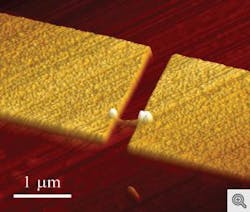Ann Arbor, MI--True single-photon emitters, which are valuable for quantum cryptography, are normally very complex devices. A true single-photon emitter always gives off one, and only one, photon at a time (as opposed to what many experimenters use as a quasi-single-photon emitter: a laser source attenuated so much that usually -- though not always! -- it emits one photon at a time, and randomly, rather than the preferable on-demand). Now, University of Michigan (U-M) researchers have demonstrated a simpler, more efficient true single-photon emitter that can be made using traditional semiconductor processing techniques.
Related: Quantum dots may hold the key to secure quantum cryptography
Related: Diamond technology enables practical single-photon sources
Related: Japanese researchers achieve record 50 km secure transmission with single-photon emitter
While the U-M researchers didn't make the first true single-photon emitter ever, they say their new device improves upon the current technology and is much easier to make.
"This thing is very, very simple. It is all based on silicon," says Pallab Bhattacharya, who leads the project and who is a co-author of a paper on the work published in Nature Communications on April 9, 2013.
Quantum dot on a nanowire
Bhattacharya's emitter is a single nanowire made of gallium nitride (GaN) with a very small region of indium gallium nitride (InGaN) that behaves as a quantum dot. The researchers grew the nanowires on a wafer of silicon. Because their technique is silicon-based, the infrastructure to manufacture the emitters on a very large scale already exists.
"This is a big step in that it produces the pathway to realizing a practical electrically injected single-photon emitter," says Bhattacharya.
Key enablers of the new technology are size and compactness. "By making the diameter of the nanowire very small and by altering the composition over a very small section of it, a quantum dot is realized," notes Bhattacharya. "The quantum dot emits single photons upon electrical excitation."
The U-M emitter is electrically rather than optically pumped, which further simplifies the device. And each photon it emits possesses the same degree of linear polarization (most other single-photon emitters release light particles with a random polarization). "So half might have one polarization and the other half might have the other," says Bhattacharya. "So in cryptic message, if you want to code them, you would only be able to use 50% of the photons. With our device, you could use almost all of them."
Although the device must be cooled for operation, the researchers are working on one that operates closer to room temperature.
The paper is titled "Electrically-driven polarized single-photon emission from an InGaN quantum dot in a GaN nanowire." The first author is Saniya Deshpande, a graduate student in electrical engineering and computer science. The work is supported by the National Science Foundation. The device was fabricated at the U-M Lurie Nanofabrication Facility.

